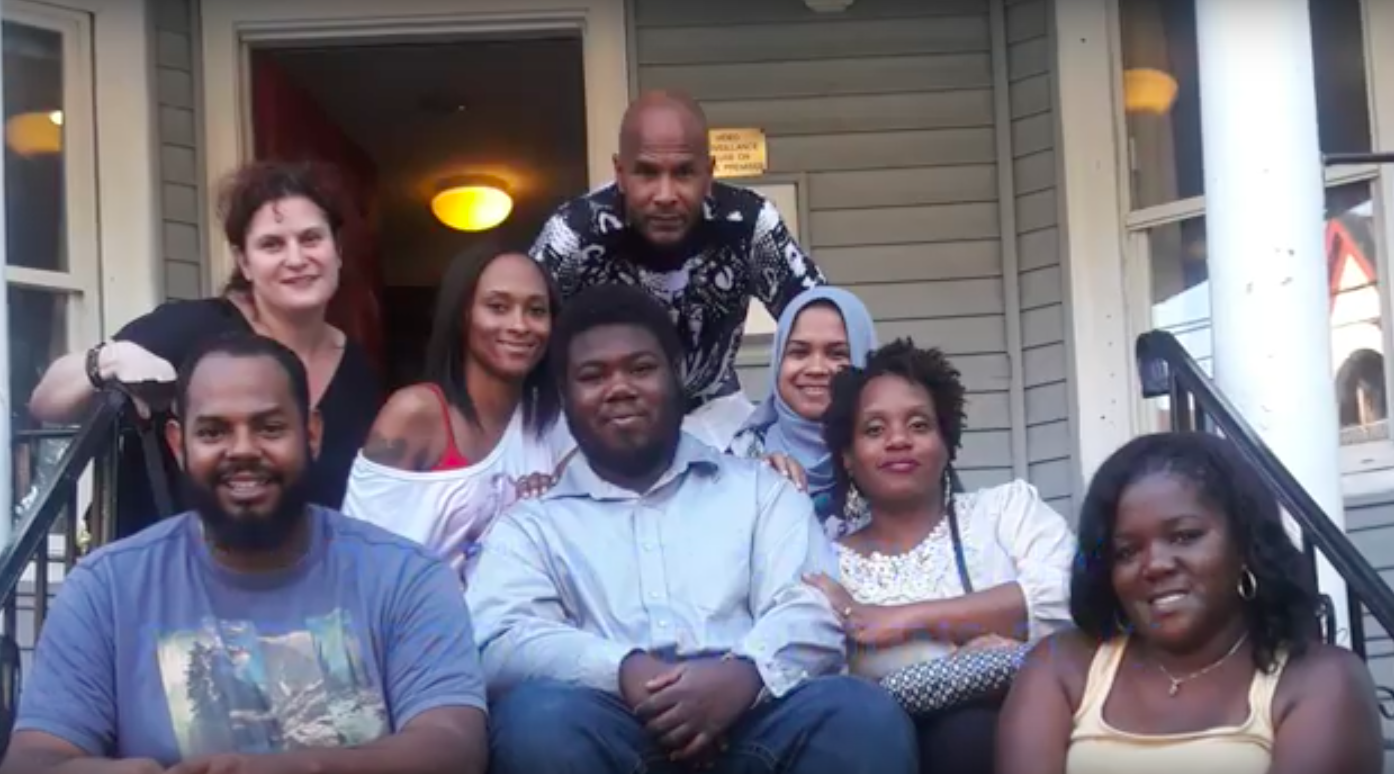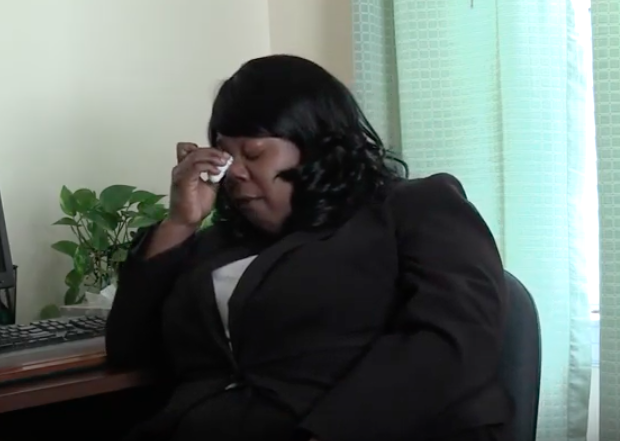
Screenshots from "Journey to Manhood" by Tyquan Ruffen
Tyquan Ruffen sits on porch steps surrounded by supportive adults, in a video he made with the staff of Roxbury House, a group home for boys in Boston where he lived as a teenager. The process of making a short life-story video encourages youth at Roxbury house to talk about their lives in a way they might otherwise not do.
When Tyquan Ruffen looks back at his life he sees a patchwork of places he’s lived. Italian Home, Knights Children Center, Harrington House, Longview Farm, Roxbury House — all group homes in Boston.
He recalls tough times, but he can also recall people who were there for him.
A photo of himself the day he left Roxbury House shows him sitting on porch steps surrounded by adults, including his mother.
“Everybody was there to support me,” he said.
Now at 21, he lives in transitional housing that prepares young people for independent living, and he’s working full time and looking ahead to college.
A short video he made in 2017 contributed to his understanding of his life. He named it “Journey to Manhood.” Producing it “took me back to memory lane,” he said.
“Journey to Manhood” was the first in a narrative video project started by Kapr Bangura, program director at Roxbury House, a residence for 12 boys ages 13-19 in the Roxbury area of Boston.
Roxbury House is part of a larger youth residential services program, the Home for Little Wanderers, which has a 200-year history in Massachusetts. The Home serves more than 12,000 youth a year from birth to age 22 through its group homes and clinical and family support, education services and transitional services for older youth.
The idea for the narrative video-making started four years ago, Bangura said.
“I wanted to have a way to have kids not used to traditional therapy tell their story,” he said.
Each boy who participates talks about his memories in front of the camera. He chooses a soundtrack with music that resonates with him, Bangura said. He acts as director/producer.
“They piece all this together with a professional editor,” he said.
Adolescent boys can be notoriously unwilling to talk about themselves. When asked to talk they’d be like “Nope, I’m out of here,” Bangura said.
“But something about the camera makes them say: ‘I can talk,’” he said.
For the video, Bangura and the staff also do interviews with other people who are important in a boy’s life — parents, grandparents, teachers, mentors and siblings, for example. The interviews “bring them back into the conversation,“ he said.
In seeing the interviews, the boys are flooded with memories, he said.
“We work with kids who’ve faced a significant amount of trauma,” Bangura said, including abuse and neglect. The video is used as a tool for therapists. It opens the door to conversation, he said.
But narrative video-making can also be a good process for kids in general, said Amanda Perkins, assistant program director at Roxbury House.
“They can get perspective,” she said. “Everyone has their story. There’s always something to learn.”
The power of narrative
While there are many ideas about the art, craft and value of storytelling, video-making at Roxbury House is based on narrative therapy, developed initially in New Zealand in the 1980s by Michael White and David Epston.
With this approach, people are seen as separate from the problems they face. Constructing a story allows a person to gain some distance from a problem and examine it in a new light. Creating a narrative for the future allows them to step away from the past story and move in another direction. They may change their thoughts about themselves and their actions.
Because a person telling the story is considered the expert on his or her story, narrative therapy can challenge “prevailing socio-cultural narratives and illustrates an alternative, richer understanding,” wrote Thommi Lawson of Webster University and Laurie Garo at University of North Carolina. Narrative therapy can be more culturally responsive and can sidestep the dominant narratives around race, they wrote.
One of Ruffen’s reasons for making a video was to reach out to other youth.

Atevia Hayes wipes her eyes as she is interviewed for her son’s video. She explains the difficulties she had with him when he was young and how she sought help for him.
“I like to help other people,” he said.
His video begins with his graduation from McKinley Preparatory School in June 2017. Then Ruffen walks through various rooms as he moves into transitional housing. The music of Mary J. Blige rises: “If you looked at my life and see what I see …” she sings, “… you’ll be at peace with yourself …”
Then the video moves into the past, as his mother, Atevia Hayes, sits at a desk and wipes her eyes. She talks about not knowing how to help her son.
“I was angry,” Ruffen says in the video.
As a young child, Ruffen was physically abused. Although his mother wanted to support and protect him, she was also going through difficulties, including mental health issues and not having a place to live.
“I didn’t know what was going on behind the scenes,” Ruffen said later. In the video, he describes running away and fighting.
“As I got older I started realizing I wasn’t around my family … and I started to get sad and depressed,” he says.
He wouldn’t describe himself as an angry person, he says in the video, although he often got into fights. He felt lonely and upset and was picked on, he recalls.
The video moves to drumming teacher Jeremiah Woodberry. At first Tyquan came in to his class with a little bit of an attitude, not wanting to do it, Woodberry says.
But he became really good, Woodberry says.
His mother talks about his aspirations and says she sees college in his future.
Words on screen: “Tyquan has plans to attend Bridgewater State University and pursue a career in social work. The challenges of his own life have inspired him to help the lives of others.”
Moments of new awareness
Another student who lived at Roxbury House, Tyrese, recorded his memories in the video project.
He recalls his first foster mother, who was steadfast in taking care of her children and many foster kids.
“My parents had nine [children]. I don’t know why they couldn’t do it,” he says. He was removed from his family as a small child.
If his foster mother could draw on her strength, so could he, he says.
From the loving memories of his foster mother he goes on to talk about the tough times — sleeping on stairs while homeless, being beaten by his father and watching his 2-year-old brother being beaten.
“I’ll never forget it … That was a hard scene to watch,” he says.
His sadness and love for his younger siblings comes through.
“They didn’t deserve this life. None of us did. … You’ve got to learn how to move on,” he says.
Perhaps recalling the love and support he did receive — and seeing it as a model he can emulate — makes it more possible to revisit the painful times. In the midst of recalling the tough times, he moves into empathy.
Talking about memories for the video is a way to take a step back and see things anew, Perkins said. It can provide transformational moments.
‘What we’re really looking for is for a kid to take ownership of their life,” she said. “They’re the experts of their life.”
They tell their story and they tell how it shaped their experience of the world and their outlook about themselves, she said.
They’ve developed survival skills, she said. They can decide how to use those skills now and in the future, she said.




























